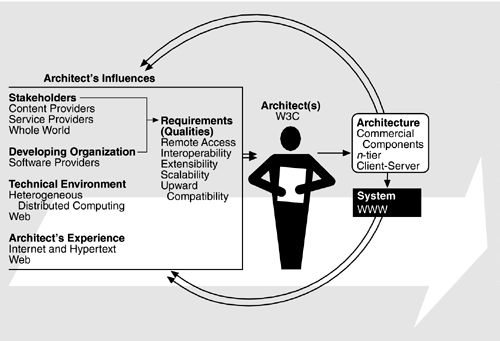13.6 The Architecture Business Cycle Today
If we look at the current state of the Web after several cycles through the ABC, we see a number of phenomena.
Several types of organizations provide the technical environment. They can be divided into service providers and content providers. Service providers produce the software that makes the Web-browsers, servers, databases, application servers, security technologies (such as firewalls), transaction servers, networks, and routers. Content providers produce the data for the Web. There is heavy competition in all of these areas. A number of open-source projects, aside from the W3C, have come to prominence in the development of the Web, particularly the Apache project. CERN has had no special role in the evolution of the Web. Web-enabled languages, particularly Java, are changing the way functionality is developed and delivered over the Web. (See Chapter 18 for an example of how Web-based applications are built using Enterprise JavaBeans.) The emergence of the Web as a distributed development environment has given rise to several new organizations and products. For example, UDDI (Universal Description, Discovery, and Integration) provides distributed Web-based registries of Web services. These services can be used as building blocks for distributed Web-based applications.
Figure 13.8 shows the ABC for the Web today.

The customers are the software server and browser providers and the service and content providers. The end users are the people of the world. The architect's role is provided by the W3C and other consortia such as UDDI, the Apache project, and several influential companies-Sun, Microsoft, and AOL/Netscape. The remainder of the ABC is the same except that the technical environment now includes the Web itself, which adds an upward compatibility requirement to the qualities.
We discussed the return cycle of the ABC in Section 1.1. The existence of a system creates new business opportunities for both the developing organization and its customers. In the World Wide Web case, the developing organization, CERN, decided that nuclear research, not Web activity, was its main business, so the business opportunities created by the return loop of the ABC were filled by other organizations.
|